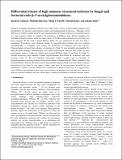| dc.contributor.author | Gerlach, Jared Q. | |
| dc.contributor.author | Kilcoyne, Michelle | |
| dc.contributor.author | Farrell, Mark P. | |
| dc.contributor.author | Kane, Marian | |
| dc.contributor.author | Joshi, Lokesh | |
| dc.date.accessioned | 2020-09-18T08:38:28Z | |
| dc.date.available | 2020-09-18T08:38:28Z | |
| dc.date.issued | 2012-02-28 | |
| dc.identifier.citation | Gerlach, Jared Q., Kilcoyne, Michelle, Farrell, Mark P., Kane, Marian, & Joshi, Lokesh. (2012). Differential release of high mannose structural isoforms by fungal and bacterial endo-β-N-acetylglucosaminidases. Molecular BioSystems, 8(5), 1472-1481. doi:10.1039/C2MB05455H | en_IE |
| dc.identifier.issn | 1742-2051 | |
| dc.identifier.uri | http://hdl.handle.net/10379/16182 | |
| dc.description.abstract | Endo-beta-N-acetylglucosaminidases (ENGases) are widely used to remove N-linked oligosaccharides from glycoproteins for glycomic and proteomic studies and biopharmaceutical processes. Although several ENGases are widely available and their main oligosaccharide structural preferences are generally known (i.e. high mannose, hybrid or complex), the preferences of ENGases from different kingdoms for individual structural isoforms within the major classes of N-linked oligosaccharides have previously not been compared. In this work, a fungal ENGase (Endo Tv) was purified for the first time from a commercial Trichoderma viride chitinase mixture by sequential anion exchange and size exclusion chromatography, a commonly used strategy for purification of chitinases and endo enzymes. Oligosaccharides released from substrate glycoproteins by Endo Tv were identified and quantified by high pH anion exchange chromatography with pulsed amperometric detection and verified by mass spectrometric analysis. Unlike the widely-used bacterial ENGases, Endo H and Endo F1, Endo Tv released exclusively high mannose N-linked oligosaccharides from RNase B, ovalbumin, and yeast invertase. Endo Tv did not hydrolyze fucosylated, hybrid, complex type or bisecting N-acetylglucosamine-containing structures from bovine fetuin, ovalbumin and IgG. When compared to the bacterial ENGase, Endo H, the relative ratio of high-mannose oligosaccharide structural isoforms released from RNase B by Endo Tv was found to differ, with Endo Tv releasing more Man(5)GlcNAc and Man(7)GlcNAc isoform I and less Man(9)GlcNAc from RNase B. Based on these data, it is suggested that use of ENGases from multiple sources may serve to balance an introduced bias in quantitative analysis of released structural isoforms and may further prove valuable in biochemical structure-function studies. | en_IE |
| dc.format | application/pdf | en_IE |
| dc.language.iso | en | en_IE |
| dc.publisher | Royal Society of Chemistry | en_IE |
| dc.relation.ispartof | Molecular Biosystems | en |
| dc.rights | Attribution-NonCommercial-NoDerivs 3.0 Ireland | |
| dc.rights.uri | https://creativecommons.org/licenses/by-nc-nd/3.0/ie/ | |
| dc.subject | ASPARAGINE-LINKED OLIGOSACCHARIDES | en_IE |
| dc.subject | 500-MEGAHERTZ H-1-NMR SPECTROSCOPY | en_IE |
| dc.subject | FLAVOBACTERIUM-MENINGOSEPTICUM | en_IE |
| dc.subject | MOLECULAR-CLONING | en_IE |
| dc.subject | TRICHODERMA-VIRIDE | en_IE |
| dc.subject | ENZYMATIC DEGLYCOSYLATION | en_IE |
| dc.subject | SUBSTRATE-SPECIFICITY | en_IE |
| dc.subject | GLYCOSYLATION SITES | en_IE |
| dc.subject | SECRETED PROTEIN | en_IE |
| dc.subject | PURIFICATION | en_IE |
| dc.title | Differential release of high mannose structural isoforms by fungal and bacterial endo-β-N-acetylglucosaminidases | en_IE |
| dc.type | Article | en_IE |
| dc.date.updated | 2020-09-18T08:26:37Z | |
| dc.identifier.doi | 10.1039/c2mb05455h | |
| dc.local.publishedsource | https://doi.org/10.1039/C2MB05455H | en_IE |
| dc.description.peer-reviewed | peer-reviewed | |
| dc.internal.rssid | 2196232 | |
| dc.local.contact | Michelle Kilcoyne, Glycosciences, School Of Natural Sciences, Nui Galway. 5885 Email: michelle.kilcoyne@nuigalway.ie | |
| dc.local.copyrightchecked | Yes | |
| dc.local.version | ACCEPTED | |
| nui.item.downloads | 88 | |


